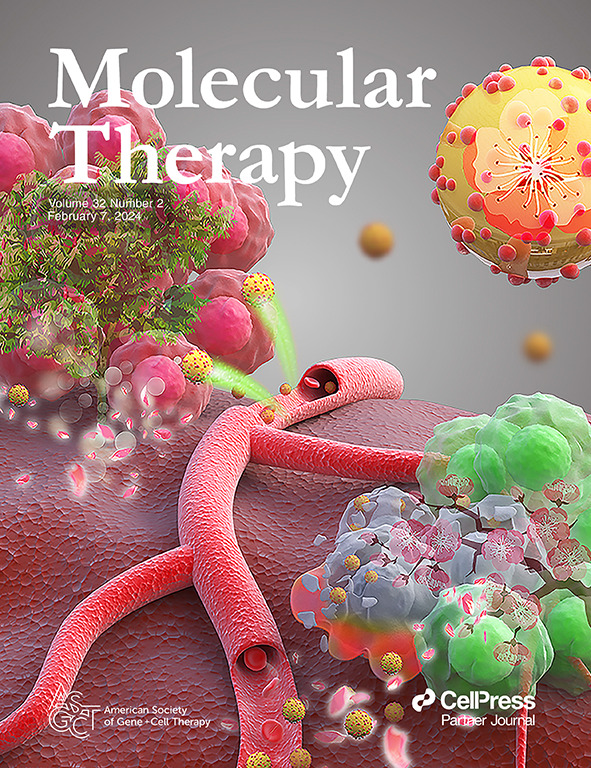BIN1基因替代可恢复与BIN1相关的中央核肌病。
IF 12.1
1区 医学
Q1 BIOTECHNOLOGY & APPLIED MICROBIOLOGY
引用次数: 0
摘要
中核性肌病(CNM)是一种严重的遗传性疾病,其特征是与肌纤维细胞器错位相关的全身性肌肉无力。大多数CNM病例是由参与膜重塑的蛋白质突变引起的,包括两栖素2 (BIN1)。目前还没有治疗方法,病理机制也不清楚。在这里,我们旨在通过基于腺相关病毒(AAV)的基因替代策略治愈Bin1-CNM小鼠模型(Bin1mck-/-)。早期全身性外源性BIN1表达可有效预防疾病进展。此外,疾病发作后BIN1的表达可以逆转治疗后四周的所有疾病体征,包括运动缺陷、肌肉无力、肌肉和肌纤维萎缩、后凸、细胞核和线粒体错位以及t小管网络改变。然后,我们验证了将肌致性AAV血清型与肌肉BIN1亚型结合的最有效构建。救援与自噬和兴奋-收缩耦合标志物的正常化有关。细胞和体内研究表明,不同的BIN1天然异构体具有相似的有益作用。对分离的蛋白质结构域进行编码的人工构建物挽救了不同的CNM标志。只有肌肉特异性的BIN1异构体结合了BIN1在膜管和动力蛋白(DNM2)调节方面的不同细胞功能,才能完全挽救。总的来说,本研究验证了BIN1基因替代是治疗BIN1相关的中心核肌病的一种有希望的策略。本文章由计算机程序翻译,如有差异,请以英文原文为准。
BIN1 gene replacement reverts BIN1-related centronuclear myopathy.
Centronuclear myopathies (CNM) are severe genetic disorders characterized by generalized muscle weakness associated with organelle mispositioning in myofibers. Most CNM cases are caused by mutations in proteins involved in membrane remodeling, including amphiphysin 2 (BIN1). There is no treatment and the pathological mechanisms are not understood. Here, we aimed to cure the Bin1-CNM mouse model (Bin1mck-/-) via an adeno-associated virus (AAV)-based gene replacement strategy. Early systemic exogenous BIN1 expression efficiently prevented disease progression. Moreover, BIN1 expression after disease onset reverted all disease signs four weeks after treatment, including motor defects, muscle weakness, muscle and myofibers hypotrophy, kyphosis, nuclei and mitochondria misposition, and altered T-tubules network. We then validated the most efficient construct combining a myotropic AAV serotype with the muscle BIN1 isoform. The rescue correlated with normalization of autophagy and excitation-contraction coupling markers. Cellular and in vivo investigations revealed that different BIN1 natural isoforms shared similar beneficial effects. Artificial constructs coding for separated protein domains rescued different CNM hallmarks. Only the muscle-specific BIN1 isoform combined the different cellular functions of BIN1 on membrane tubulation and dynamin (DNM2) regulation necessary for a full rescue. Overall, this study validates BIN1 gene replacement as a promising strategy to cure BIN1-related centronuclear myopathy.
求助全文
通过发布文献求助,成功后即可免费获取论文全文。
去求助
来源期刊

Molecular Therapy
医学-生物工程与应用微生物
CiteScore
19.20
自引率
3.20%
发文量
357
审稿时长
3 months
期刊介绍:
Molecular Therapy is the leading journal for research in gene transfer, vector development, stem cell manipulation, and therapeutic interventions. It covers a broad spectrum of topics including genetic and acquired disease correction, vaccine development, pre-clinical validation, safety/efficacy studies, and clinical trials. With a focus on advancing genetics, medicine, and biotechnology, Molecular Therapy publishes peer-reviewed research, reviews, and commentaries to showcase the latest advancements in the field. With an impressive impact factor of 12.4 in 2022, it continues to attract top-tier contributions.
 求助内容:
求助内容: 应助结果提醒方式:
应助结果提醒方式:


